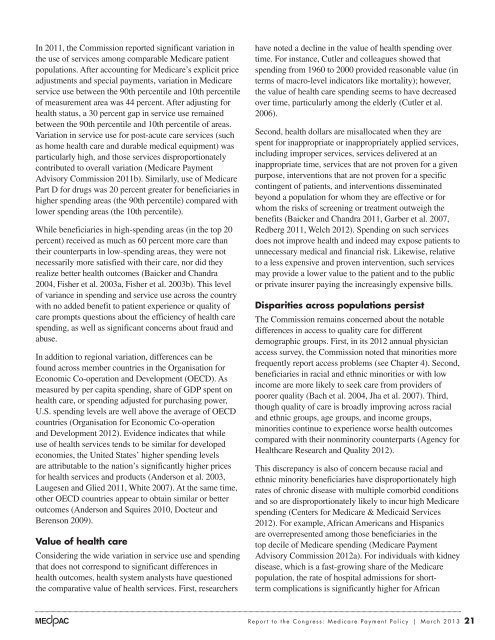Medicare Payment Policy
Medicare Payment Policy
Medicare Payment Policy
You also want an ePaper? Increase the reach of your titles
YUMPU automatically turns print PDFs into web optimized ePapers that Google loves.
In 2011, the Commission reported significant variation in<br />
the use of services among comparable <strong>Medicare</strong> patient<br />
populations. After accounting for <strong>Medicare</strong>’s explicit price<br />
adjustments and special payments, variation in <strong>Medicare</strong><br />
service use between the 90th percentile and 10th percentile<br />
of measurement area was 44 percent. After adjusting for<br />
health status, a 30 percent gap in service use remained<br />
between the 90th percentile and 10th percentile of areas.<br />
Variation in service use for post-acute care services (such<br />
as home health care and durable medical equipment) was<br />
particularly high, and those services disproportionately<br />
contributed to overall variation (<strong>Medicare</strong> <strong>Payment</strong><br />
Advisory Commission 2011b). Similarly, use of <strong>Medicare</strong><br />
Part D for drugs was 20 percent greater for beneficiaries in<br />
higher spending areas (the 90th percentile) compared with<br />
lower spending areas (the 10th percentile).<br />
While beneficiaries in high-spending areas (in the top 20<br />
percent) received as much as 60 percent more care than<br />
their counterparts in low-spending areas, they were not<br />
necessarily more satisfied with their care, nor did they<br />
realize better health outcomes (Baicker and Chandra<br />
2004, Fisher et al. 2003a, Fisher et al. 2003b). This level<br />
of variance in spending and service use across the country<br />
with no added benefit to patient experience or quality of<br />
care prompts questions about the efficiency of health care<br />
spending, as well as significant concerns about fraud and<br />
abuse.<br />
In addition to regional variation, differences can be<br />
found across member countries in the Organisation for<br />
Economic Co-operation and Development (OECD). As<br />
measured by per capita spending, share of GDP spent on<br />
health care, or spending adjusted for purchasing power,<br />
U.S. spending levels are well above the average of OECD<br />
countries (Organisation for Economic Co-operation<br />
and Development 2012). Evidence indicates that while<br />
use of health services tends to be similar for developed<br />
economies, the United States’ higher spending levels<br />
are attributable to the nation’s significantly higher prices<br />
for health services and products (Anderson et al. 2003,<br />
Laugesen and Glied 2011, White 2007). At the same time,<br />
other OECD countries appear to obtain similar or better<br />
outcomes (Anderson and Squires 2010, Docteur and<br />
Berenson 2009).<br />
Value of health care<br />
Considering the wide variation in service use and spending<br />
that does not correspond to significant differences in<br />
health outcomes, health system analysts have questioned<br />
the comparative value of health services. First, researchers<br />
have noted a decline in the value of health spending over<br />
time. For instance, Cutler and colleagues showed that<br />
spending from 1960 to 2000 provided reasonable value (in<br />
terms of macro-level indicators like mortality); however,<br />
the value of health care spending seems to have decreased<br />
over time, particularly among the elderly (Cutler et al.<br />
2006).<br />
Second, health dollars are misallocated when they are<br />
spent for inappropriate or inappropriately applied services,<br />
including improper services, services delivered at an<br />
inappropriate time, services that are not proven for a given<br />
purpose, interventions that are not proven for a specific<br />
contingent of patients, and interventions disseminated<br />
beyond a population for whom they are effective or for<br />
whom the risks of screening or treatment outweigh the<br />
benefits (Baicker and Chandra 2011, Garber et al. 2007,<br />
Redberg 2011, Welch 2012). Spending on such services<br />
does not improve health and indeed may expose patients to<br />
unnecessary medical and financial risk. Likewise, relative<br />
to a less expensive and proven intervention, such services<br />
may provide a lower value to the patient and to the public<br />
or private insurer paying the increasingly expensive bills.<br />
Disparities across populations persist<br />
The Commission remains concerned about the notable<br />
differences in access to quality care for different<br />
demographic groups. First, in its 2012 annual physician<br />
access survey, the Commission noted that minorities more<br />
frequently report access problems (see Chapter 4). Second,<br />
beneficiaries in racial and ethnic minorities or with low<br />
income are more likely to seek care from providers of<br />
poorer quality (Bach et al. 2004, Jha et al. 2007). Third,<br />
though quality of care is broadly improving across racial<br />
and ethnic groups, age groups, and income groups,<br />
minorities continue to experience worse health outcomes<br />
compared with their nonminority counterparts (Agency for<br />
Healthcare Research and Quality 2012).<br />
This discrepancy is also of concern because racial and<br />
ethnic minority beneficiaries have disproportionately high<br />
rates of chronic disease with multiple comorbid conditions<br />
and so are disproportionately likely to incur high <strong>Medicare</strong><br />
spending (Centers for <strong>Medicare</strong> & Medicaid Services<br />
2012). For example, African Americans and Hispanics<br />
are overrepresented among those beneficiaries in the<br />
top decile of <strong>Medicare</strong> spending (<strong>Medicare</strong> <strong>Payment</strong><br />
Advisory Commission 2012a). For individuals with kidney<br />
disease, which is a fast-growing share of the <strong>Medicare</strong><br />
population, the rate of hospital admissions for shortterm<br />
complications is significantly higher for African<br />
Report to the Congress: <strong>Medicare</strong> <strong>Payment</strong> <strong>Policy</strong> | March 2013<br />
21


